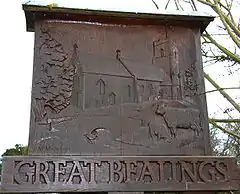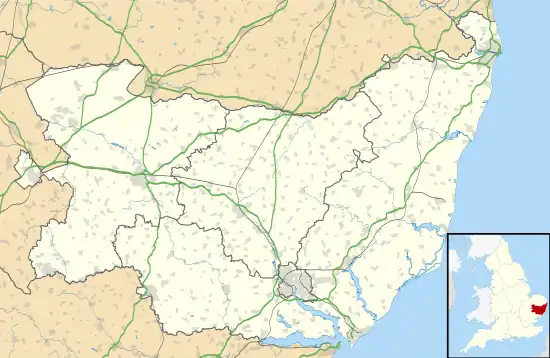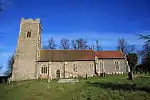| Great Bealings | |
|---|---|
 Great Bealings village sign | |
 Great Bealings Location within Suffolk | |
| Area | 4.19 km2 (1.62 sq mi) |
| Population | 302 (2011) |
| • Density | 72/km2 (190/sq mi) |
| OS grid reference | TM231489 |
| District | |
| Shire county | |
| Region | |
| Country | England |
| Sovereign state | United Kingdom |
| Post town | Woodbridge |
| Postcode district | IP13 |
| Dialling code | 01473 |
| Police | Suffolk |
| Fire | Suffolk |
| Ambulance | East of England |
| UK Parliament | |
Great Bealings is a small village in Suffolk, England. It has about 302 people living in it in around 113 households.[1] Its nearest towns are Ipswich (6 miles (9.7 km) away) and Woodbridge (2.6 miles (4.2 km)). Nearby villages include Little Bealings, Playford, Culpho, Hasketon and Grundisburgh. The village does not have an obvious centre, and the population is split between two areas — one around Lower Street to the East of the village, and the other at Boot Street/Grundisburgh Road to the West of the village. St Mary's, the village church, is about in the middle of these two centres of population.
The village shares a playing field with Little Bealings, which is located behind the joint Village Hall, and includes a grassed plateau, a fenced and hard surfaced multi-sports court, children's play equipment, and a boules piste. It is named after John Ganzoni, Lord Belstead, who lived in the village for many years, and whose Charitable Trust Fund supported the project.
The River Lark passes through the middle of the village, and is crossed by the main road with a humpback bridge.[2]
History
In the Domesday Book there is mention of the Saxon Hall, owned by Halden, with Anund the priest in attendance. This was on the meadow by the church and was owned by several families such as the de Peche, Clench, and Majors, who knocked it down in 1775 to use the material to aid the construction of Bealings House.
The village has always had a strong agricultural base with several small farms. In White's gazetteer of Suffolk in 1855, the listed tradesmen are: brickmaker, two boot makers, builder, wheelwright, blacksmith, gardener, shopkeeper, and miller as well as several farmers and gentlemen.
Historical writings
In 1870–72, John Marius Wilson's Imperial Gazetteer of England and Wales described the village as:
- BEALINGS (Great), a parish in Woodbridge district, Suffolk; on a branch of the Deben river, and on the East Suffolk railway, near Bealings station, 2¼. miles W by S of Woodbridge. Post Town, Little Bealings, under Woodbridge. Acres, 1,029. Real property, £2,091. Pop., 338. Houses, 88. The property is divided among a few; and much of it belongs to-Lord Henniker. The living is a rectory in the diocese of Norwich. Value, £250.* Patron, Lord Henniker. The church is good.[3]
In 1887, John Bartholomew also wrote an entry on Great Bealings in the Gazetteer of the British Isles with a much shorter description:
- Bealings, Great, par., E. Suffolk, 2½ miles W. of Woodbridge, 1036 ac., pop. 287.[4]
Notable residents
- The Seckford family had been landowners in the time of Edward I, with local benefactor Thomas Seckford rebuilding Seckford Hall as the country residence in 1530. He was a close advisor to Elizabeth I. His parents are buried in Great Bealings Church.
- Admiral Pelham Aldrich, who was Admiral-superintendent, Portsmouth, and attended several surveying expeditions around the world, was a resident and is buried in the churchyard and became the namesake of Mount Aldrich.
- Major Edward Moor. He served with the East India Company, being wounded three times, rising to the rank of brevet-captain. He was a Fellow of the Royal Society and an author on Indian mythology. He wrote the mystery, Bealings Bells, published in 1841, about an apparently haunted system of bell-pulls. In the 1820s, with the help of his son the Reverend Edward James Moor, he built a low pyramid southeast of Bealings House, about ten feet (three metres) high, of mixed found materials (including mill-wheels) but incorporating at the apex the triple-headed figure of Shiva and in a niche the seated figure of Brahma. These were found by Moor on Malabar Point, Bombay, and appear to be 11th century. His son-in-law William Page Wood, 1st Baron Hatherley PC, a lawyer and statesman who served as a Liberal Lord Chancellor from 1868 to 1872 in William Ewart Gladstone's first ministry, is buried in the churchyard.
- General Sir Richard Thomas Farren GCB, a British Army officer who became General Officer Commanding Eastern District lived in Bealings House form before 1891 and was buried in the churchyard on 4 January 1910 aged 92 years.[5] There is a memorial to him within the church.[6]
- Winifred Beech, the author and wife of Sir John Fortescue, was born in Great Bealings rectory, the daughter of Rector Howard Beech, in 1888.
- John Ganzoni, 2nd Baron Belstead, Baron Ganzoni PC, a Conservative politician and peer who served as Leader of the House of Lords under Margaret Thatcher from 1988 to 1990, is buried in the churchyard.
- Cynthia Cooke (1919-2016), military nurse and nursing administrator who served as Matron-in-Chief of the Queen Alexandra's Royal Naval Nursing Service, the nursing branch of the Her Majesty's Naval Service. She was appointed a Commander of the Order of St John in 1974, and a Commander of the Order of the British Empire in the 1975 Birthday Honours.
Rectors of the Parish
Plaques in the church list the following Rectors:
Anund the Priest 1086 Mathew de Stanton 1306 Geoffrey de Banhale 1307 Richard de Westhorpe 1331 Reginald Bustard 1338 Stephen de Duddeley 1341 Robert de Appleton 1343 Radulphus de Ipswich 1349 Nicholas de Lydgate 1349 John Joye 1350 William de Drayton 1352 Robert de Hethe 1375 John Tubbyng 1395 John Stratton 1407 William Jowle 1448 Robert Coppyng 1464 John Jacob 1476 Richard Williamson 1517 John Walker 1517 John Fayerthwat 1536 Robert Baxter 1542 Robert Gybsonne 1560 Richard Larwood 1566 Robert Hutchinson M.A. 1607 William Gibbins B.A. 1629 Edmund Smith B.A. 1653 Edmund Brome 1672 Richard Cavell 1719 Robert Hingeston M.A. 1726 Wm Dobbyns Humphrey 1766 Philip Meadows B.A. 1804 Wm Chafie Henniker M.A. 1838 Edward Jas. Moor B.A. 1844 Howard Beech M.A. 1886 Francis B Champion M.A. 1917 Frank Mitton 1930 George H Round-Turner 1936 David T Jarvis B.A. 1945 John McMillen O.C.S. 1954 Denis Spencer A.K.C. 1956 J G Steven A.L.C.D H.C.R 1970 Frank Hollingsworth 1975 Michael Skliros 1991 Christine Everett 1996 Pauline Stentiford 2003 Celia Cook 2015
Images of Great Bealings
 St Mary's church from over the Lark
St Mary's church from over the Lark And from its churchyard
And from its churchyard The old vicarage - Lord Belstead's home until his death
The old vicarage - Lord Belstead's home until his death The hump-backed bridge
The hump-backed bridge The River Lark from the bridge
The River Lark from the bridge The war memorial
The war memorial
Related pages
External links
References
- ↑ "Parish population 2011". Retrieved 14 September 2015.
- ↑ Great Bealings History
- ↑ "BEALINGS (Great) | As described in John Marius Wilson's Imperial Gazetteer of England and Wales (1870-72)". www.visionofbritain.org.uk. Retrieved 17 March 2020.
- ↑ "Bealings, Great | As described in John Bartholomew's Gazetteer of the British Isles (1887)". www.visionofbritain.org.uk. Retrieved 17 March 2020.
- ↑ "Records for Richard T Farren". Residents of Great Bealings. Retrieved 7 November 2018.
- ↑ "Richard Thomas Farren". Retrieved 4 April 2017.